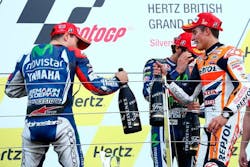Repsol Honda’s Marc Marquez won a thrilling battle with Movistar Yamaha MotoGP’s Jorge Lorenzo at last Sunday’s British Grand Prix at Silverstone, the pair finishing first and second respectively with just 0.732 seconds between them, ahead of Valentino Rossi in third place on the other factory Yamaha M1.
After a chilly start to the race weekend conditions for Sunday’s race were relatively warm, with a peak track temperature of 34°C recorded at the start of the twenty-lap contest. The warmer weather created good conditions for Marquez and Lorenzo to set a fierce pace at the front of the field, with the winner Marquez recording the fastest ever total race time for a rider at a MotoGP race at Silverstone.
Q&A with Shinji Aoki – Manager, Bridgestone Motorcycle tire Development Department
This year Bridgestone brought an expanded front slick tire allocation to Silverstone. Was this a positive change for the riders at last weekend’s British Grand Prix?
“Yes, I think this was a good change. We expanded our allocation to bring our softest front slick option, the extra-soft compound which gives the very best warm-up performance. The riders were happy to have this option in their allocation, particularly for the cool morning sessions as it allowed them to safely get up to speed around the circuit, and helped reduce the effect of the bumps on track. As the track conditions improved over the weekend and in the warmer afternoon sessions, the riders then had the soft and medium compound front slicks on offer which gave better cornering and braking stability. So at Silverstone, the riders had a front slick tire compound to manage every situation over the race weekend.”
For most of the race weekend temperatures were much cooler than were experienced last year at Silverstone. What effect did this have on tire performance?
“Excessively cool conditions always make it harder for riders to get their tires in their optimum temperature range, but once again I think our expanded front tire allocation helped in this regard. Cool and windy conditions are not unusual at the British Grand Prix so we were well prepared for this. The reduced grip in cool conditions also made it more difficult for the riders to deal with the bumpy track surface and especially on the first day of the race weekend, some teams found it difficult to find a setup that got the best potential out of the tires. However, our tire engineers worked closely with the teams and riders to help find a solution, and by Saturday afternoon most riders were able to find a setup that used the tires more effectively. The warmer temperatures on Sunday were also a welcome change, as it allowed riders to get their tires in the optimum working range much quicker.”
The Silverstone circuit has one of the highest average speeds on the MotoGP calendar, but also experiences some of the coolest track temperatures. How does Bridgestone manage to provide enough performance for the demands of this circuit, while maintaining high levels of safety for the riders?
“The mix of high average speeds and cool temperatures does pose quite a challenge for tire development. Last weekend’s FP3 session experienced the coolest track temperature we’ve had all year, just 19°C, yet the average speed this year was over 173 kilometers per hour. This means finding a good balance between safety and performance is very important. We developed our Silverstone tire allocation to ensure maximum rider safety – which is always our priority – hence why our front tires featured our softest rubber compounds, while our rear slick allocation was also engineered to work in low temperatures. Despite this focus on ensuring rider safety, the overall race time at this year’s British Grand Prix was the quickest ever, so this is a good indication that our tire allocation for Silverstone not only provided safety for the riders, but offered very good performance as well.”



